TOYOTA LAND CRUISER 2015 J200 Owners Manual
Manufacturer: TOYOTA, Model Year: 2015, Model line: LAND CRUISER, Model: TOYOTA LAND CRUISER 2015 J200Pages: 728, PDF Size: 10.53 MB
Page 291 of 728
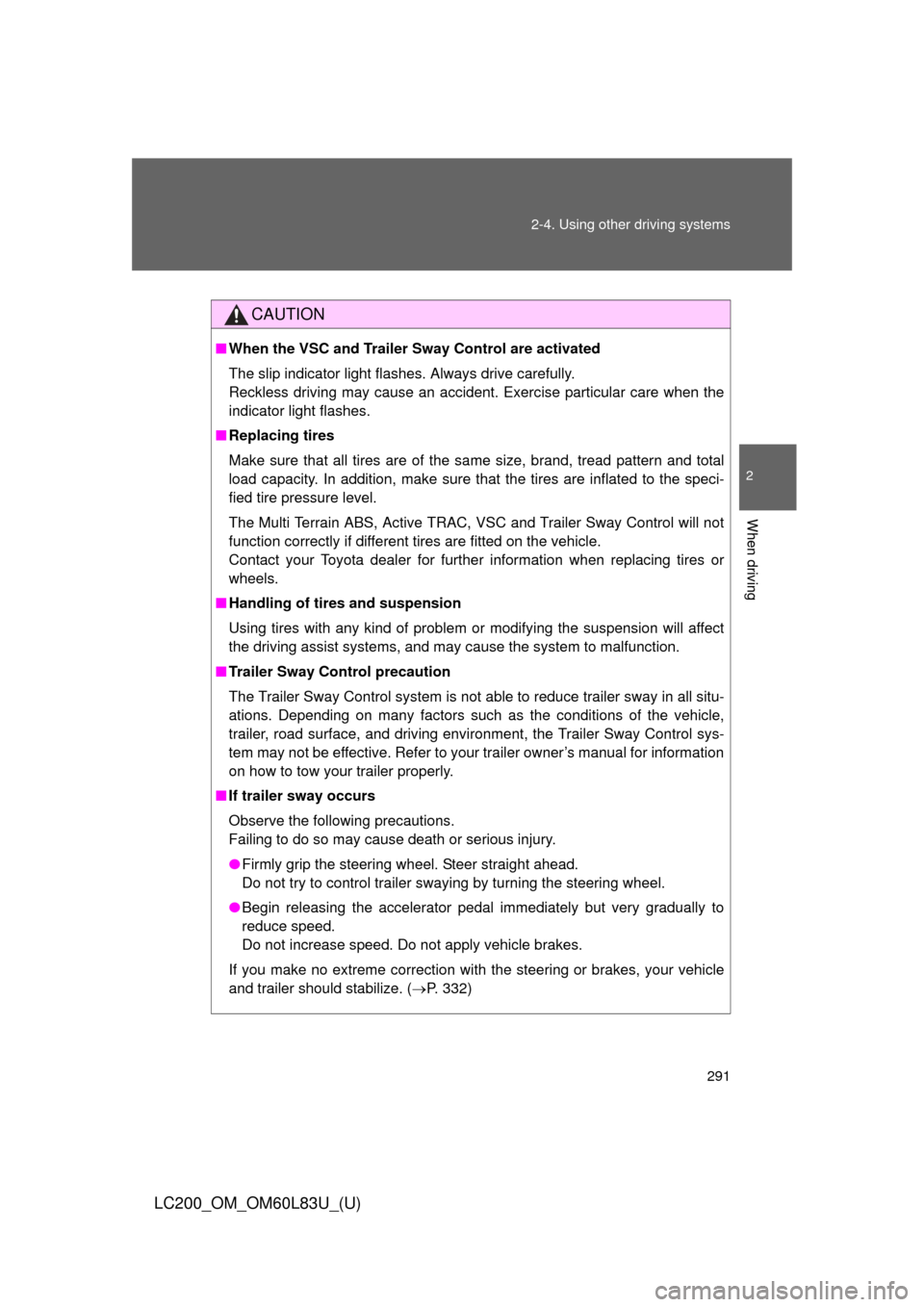
291
2-4. Using other
driving systems
2
When driving
LC200_OM_OM60L83U_(U)
CAUTION
■When the VSC and Trailer Sway Control are activated
The slip indicator light flashes. Always drive carefully.
Reckless driving may cause an accident. Exercise particular care when the
indicator light flashes.
■ Replacing tires
Make sure that all tires are of the same size, brand, tread pattern and total
load capacity. In addition, make sure that the tires are inflated to the speci-
fied tire pressure level.
The Multi Terrain ABS, Active TRAC, VSC and Trailer Sway Control will not
function correctly if different tires are fitted on the vehicle.
Contact your Toyota dealer for further information when replacing tires or
wheels.
■ Handling of tires and suspension
Using tires with any kind of problem or modifying the suspension will affect
the driving assist systems, and may cause the system to malfunction.
■ Trailer Sway Control precaution
The Trailer Sway Control system is not able to reduce trailer sway in all situ-
ations. Depending on many factors such as the conditions of the vehicle,
trailer, road surface, and driving environment, the Trailer Sway Control sys-
tem may not be effective. Refer to your trailer owner’s manual for information
on how to tow your trailer properly.
■ If trailer sway occurs
Observe the following precautions.
Failing to do so may cause death or serious injury.
●Firmly grip the steering wheel. Steer straight ahead.
Do not try to control trailer swaying by turning the steering wheel.
● Begin releasing the accelerator pedal immediately but very gradually to
reduce speed.
Do not increase speed. Do not apply vehicle brakes.
If you make no extreme correction with the steering or brakes, your vehicle
and trailer should stabilize. ( P. 332)
Page 292 of 728

292 2-4. Using other driving systems
LC200_OM_OM60L83U_(U)
NOTICE
■KDSS
In the following situations, there is the possibility that a system malfunction
has occurred, and drive comfort and the vehicle’s ability to travel on poor
road surfaces may be reduced. Take the vehicle to your Toyota dealer imme-
diately.
●When turning a corner, the vehicle’s body seems to roll further than nor-
mal.
● If after the vehicle has been left in a slanted position for a long time, for
example with the wheels of one side parked on a curb, the vehicle does
not return to level when driving (the vehicle remains slanted to one side
after returning the vehicle to level ground).
Page 293 of 728
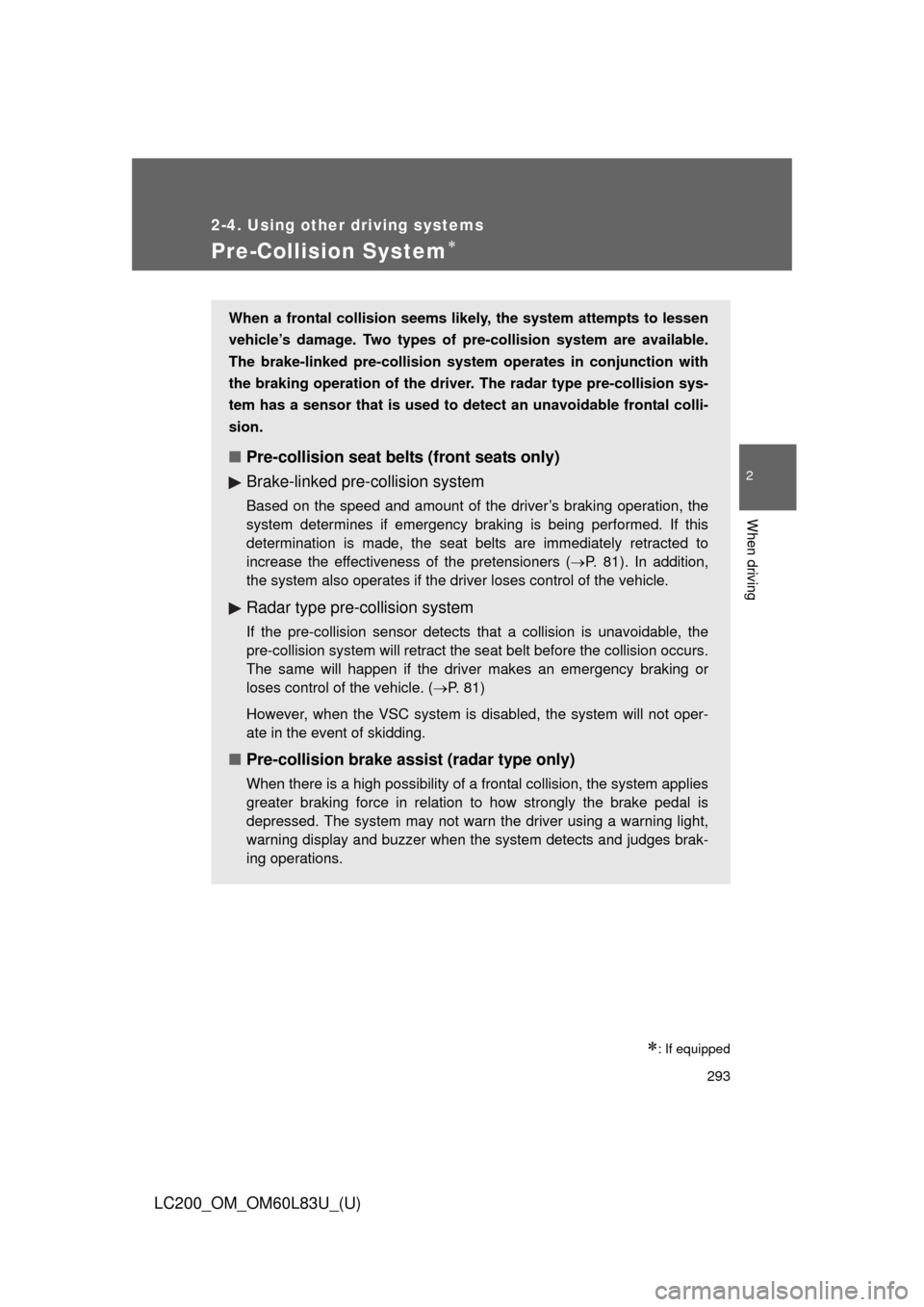
293
2-4. Using other driving systems
2
When driving
LC200_OM_OM60L83U_(U)
Pre-Collision System
: If equipped
When a frontal collision seems likely, the system attempts to lessen
vehicle’s damage. Two types of pre-collision system are available.
The brake-linked pre-collision system operates in conjunction with
the braking operation of the driver . The radar type pre-collision sys-
tem has a sensor that is used to de tect an unavoidable frontal colli-
sion.
■ Pre-collision seat belts (front seats only)
Brake-linked pre-collision system
Based on the speed and amount of the driver’s braking operation, the
system determines if emergency braking is being performed. If this
determination is made, the seat bel ts are immediately retracted to
increase the effectiveness of the pretensioners ( P. 81). In addition,
the system also operates if the driver loses control of the vehicle.
Radar type pre-collision system
If the pre-collision sensor detects that a collision is unavoidable, the
pre-collision system will retract the seat belt before the collision occurs.
The same will happen if the driver makes an emergency braking or
loses control of the vehicle. ( P. 81)
However, when the VSC system is disabled, the system will not oper-
ate in the event of skidding.
■ Pre-collision brake assist (radar type only)
When there is a high possibility of a frontal collision, the system applies
greater braking force in relation to how strongly the brake pedal is
depressed. The system may not warn the driver using a warning light,
warning display and buzzer when the system detects and judges brak-
ing operations.
Page 294 of 728
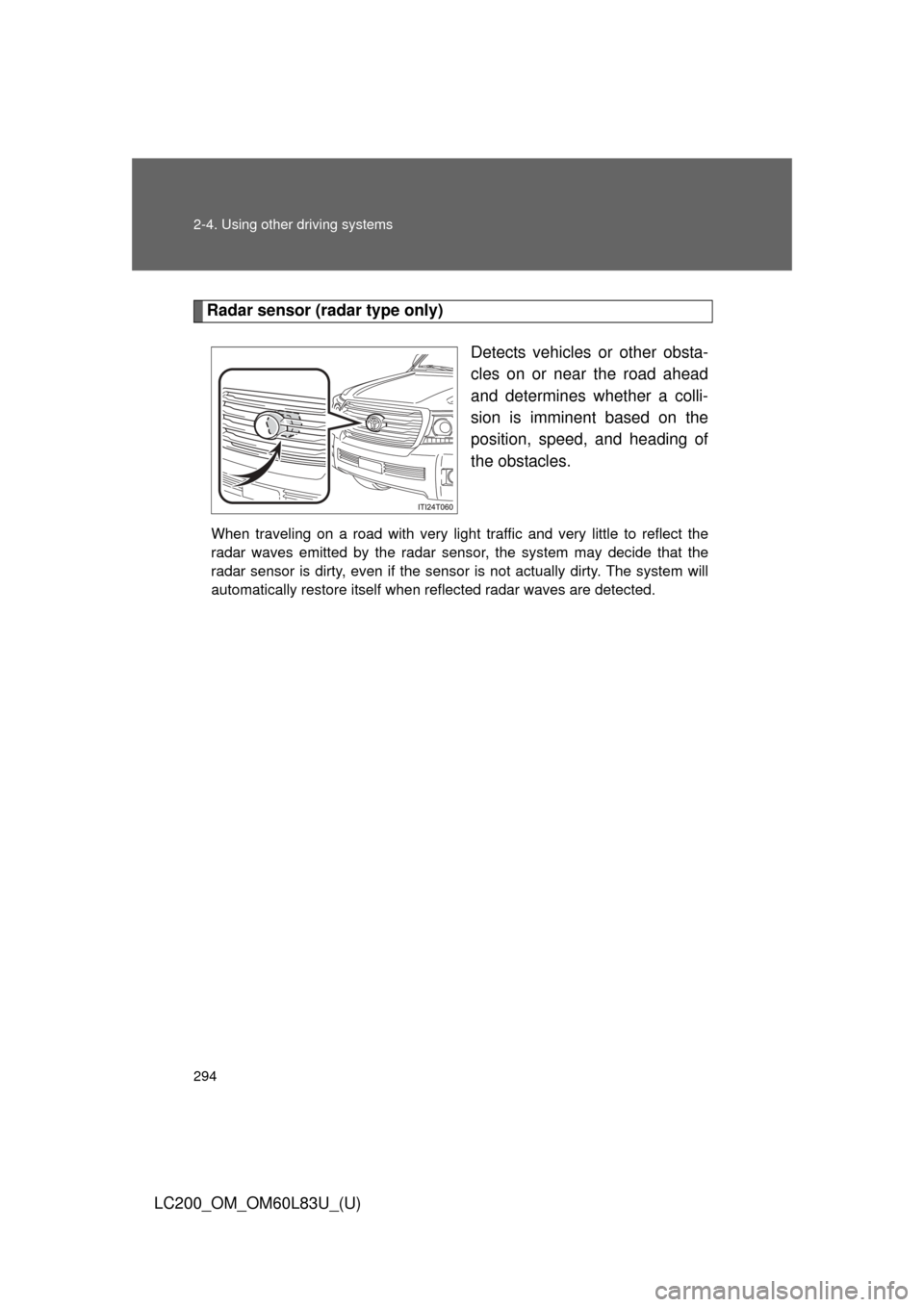
294 2-4. Using other driving systems
LC200_OM_OM60L83U_(U)
Radar sensor (radar type only)Detects vehicles or other obsta-
cles on or near the road ahead
and determines whether a colli-
sion is imminent based on the
position, speed, and heading of
the obstacles.
When traveling on a road with very light traffic and very little to reflect the
radar waves emitted by the radar sensor, the system may decide that the
radar sensor is dirty, even if the sensor is not actually dirty. The system will
automatically restore itself when reflected radar waves are detected.
Page 295 of 728
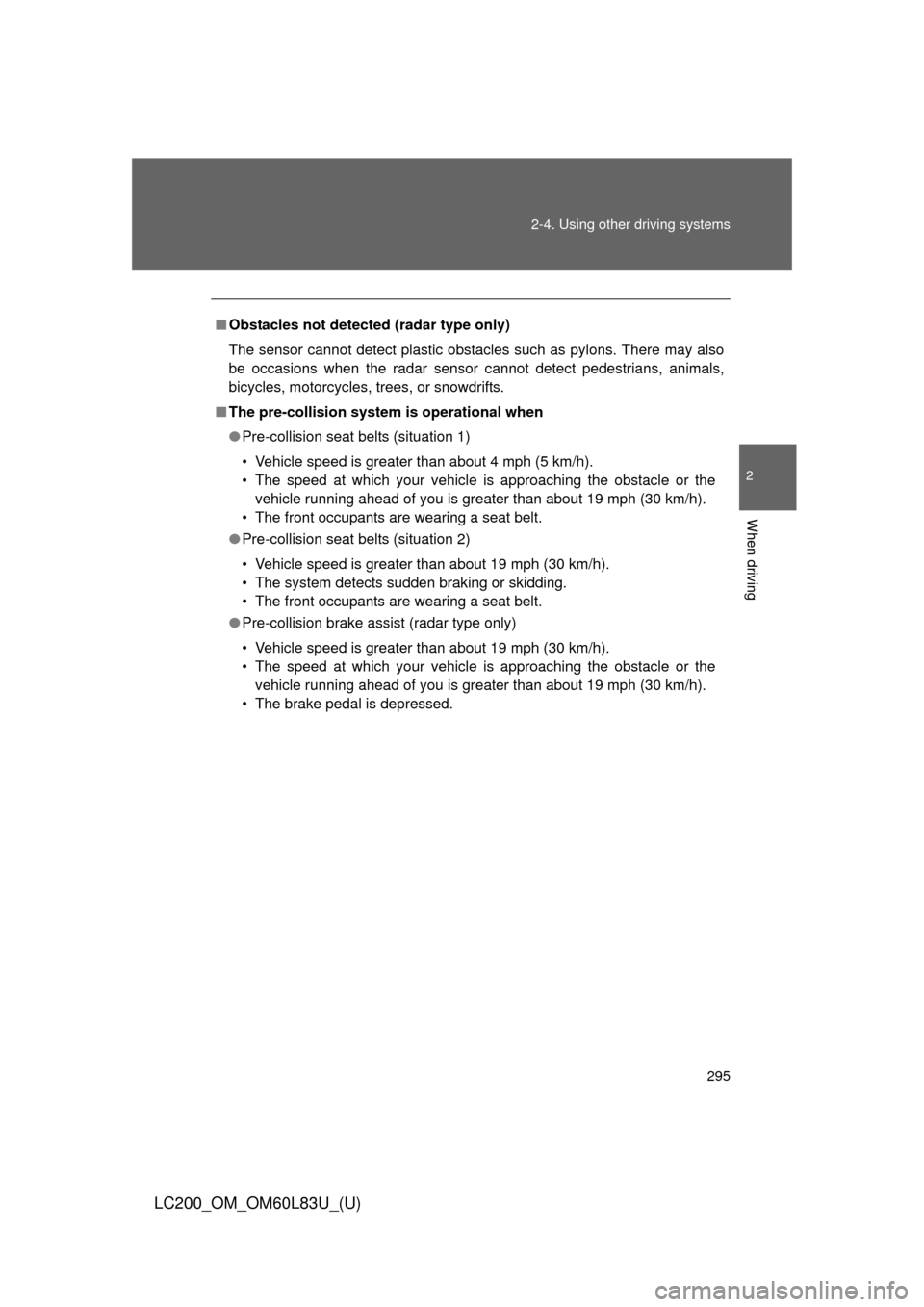
295
2-4. Using other
driving systems
2
When driving
LC200_OM_OM60L83U_(U)
■Obstacles not detected (radar type only)
The sensor cannot detect plastic obstacles such as pylons. There may also
be occasions when the radar sensor cannot detect pedestrians, animals,
bicycles, motorcycles, trees, or snowdrifts.
■ The pre-collision system is operational when
●Pre-collision seat belts (situation 1)
• Vehicle speed is greater than about 4 mph (5 km/h).
• The speed at which your vehicle is approaching the obstacle or the
vehicle running ahead of you is greater than about 19 mph (30 km/h).
• The front occupants are wearing a seat belt.
● Pre-collision seat belts (situation 2)
• Vehicle speed is greater than about 19 mph (30 km/h).
• The system detects sudden braking or skidding.
• The front occupants are wearing a seat belt.
● Pre-collision brake assist (radar type only)
• Vehicle speed is greater than about 19 mph (30 km/h).
• The speed at which your vehicle is approaching the obstacle or the
vehicle running ahead of you is greater than about 19 mph (30 km/h).
• The brake pedal is depressed.
Page 296 of 728

296 2-4. Using other driving systems
LC200_OM_OM60L83U_(U)
■Conditions that may trigger the system even if there is no possibility of
collision
● When there is an object by the roadside at the entrance to a curve
● When passing an oncoming vehicle on a curve
● When driving over a narrow iron bridge
● When there is a metal object on the road surface
● When driving on an uneven road surface (nose up, nose down)
● When passing an oncoming vehicle on a left-turn
● When your vehicle rapidly closes on the vehicle in front
● When a grade separation/interchange, sign, billboard, or other structure
appears to be directly in the vehicle’s line of travel
● When climbing a steep hill causes an overhead billboard or other metallic
structure to appear directly in the vehicle’s line of travel
● When an extreme change in vehicle height occurs
● When the axis of the radar is out of adjustment
● When passing through certain toll gates
● When passing through an overpass
● When passing through a tunnel
When the system is activated in the situations described above there is also
a possibility that the seat belts will retract quickly and the brakes will be
applied with a force greater than normal. When the seat belt is locked in the
retracted position, stop the vehicle in a safe place, release the seat belt and
refasten.
Page 297 of 728
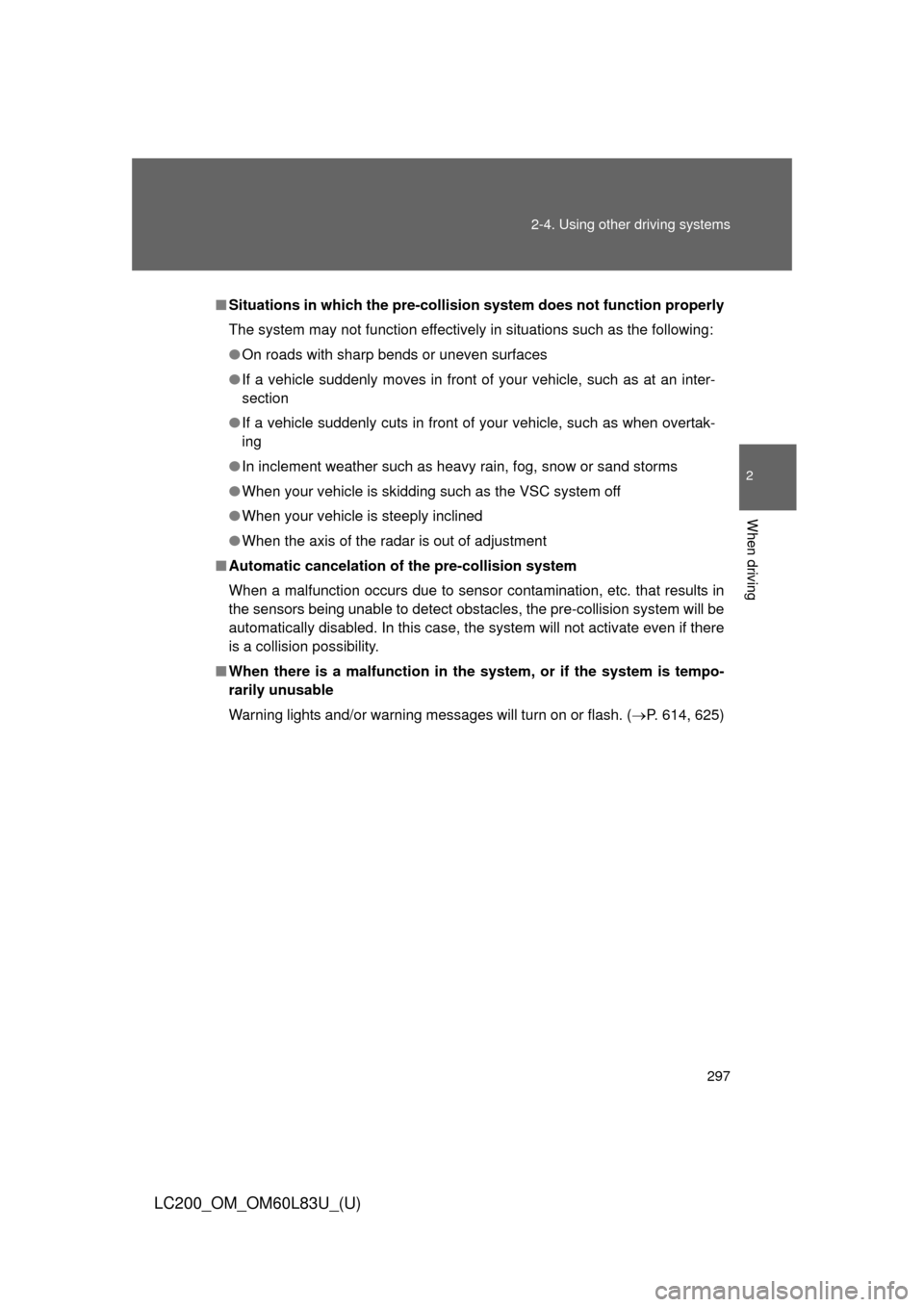
297
2-4. Using other
driving systems
2
When driving
LC200_OM_OM60L83U_(U)
■Situations in which the pre-collis ion system does not function properly
The system may not function effectively in situations such as the following:
● On roads with sharp bends or uneven surfaces
● If a vehicle suddenly moves in front of your vehicle, such as at an inter-
section
● If a vehicle suddenly cuts in front of your vehicle, such as when overtak-
ing
● In inclement weather such as heavy rain, fog, snow or sand storms
● When your vehicle is skidding such as the VSC system off
● When your vehicle is steeply inclined
● When the axis of the radar is out of adjustment
■ Automatic cancelation of the pre-collision system
When a malfunction occurs due to sensor contamination, etc. that results in
the sensors being unable to detect obstacles, the pre-collision system will be
automatically disabled. In this case, the system will not activate even if there
is a collision possibility.
■ When there is a malfunction in the system, or if th e system is tempo-
rarily unusable
Warning lights and/or warning messages will turn on or flash. ( P. 614, 625)
Page 298 of 728

298 2-4. Using other driving systems
LC200_OM_OM60L83U_(U)
■Certification (radar type only)
FCC ID: HYQDNMWR005
This device complies with part 15 of the FCC Rules. Operation is subject to
the following two conditions: (1) This device may not cause harmful interfer-
ence, and (2) this device must accept any interference received, including
interference that may cause undesired operation.
FCC WARNING
Changes or modifications not expressly approved by the party responsible
for compliance could void the user’s authority to operate the equipment.
Radiofrequency radiation exposure Information:
This equipment complies with FCC radiation exposure limits set forth for an
uncontrolled environment.
This equipment should be installed and operated with minimum distance of
20 cm between the radiator (antenna) and your body.
This transmitter must not be co-located or operating in conjunction with any
other antenna or transmitter.
Page 299 of 728
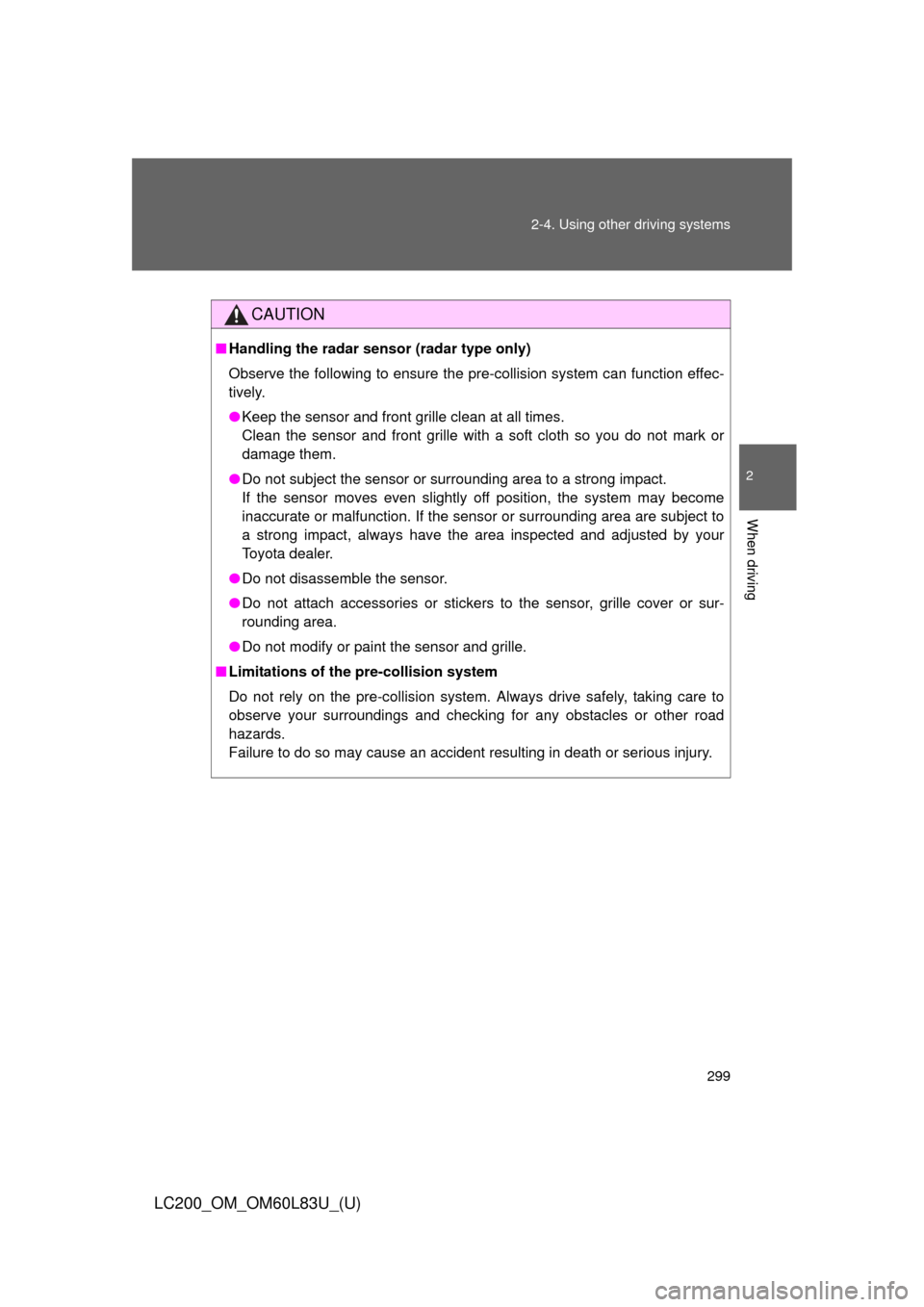
299
2-4. Using other
driving systems
2
When driving
LC200_OM_OM60L83U_(U)
CAUTION
■Handling the radar sensor (radar type only)
Observe the following to ensure the pre-collision system can function effec-
tively.
●Keep the sensor and front grille clean at all times.
Clean the sensor and front grille with a soft cloth so you do not mark or
damage them.
● Do not subject the sensor or surrounding area to a strong impact.
If the sensor moves even slightly off position, the system may become
inaccurate or malfunction. If the sensor or surrounding area are subject to
a strong impact, always have the area inspected and adjusted by your
Toyota dealer.
● Do not disassemble the sensor.
● Do not attach accessories or stickers to the sensor, grille cover or sur-
rounding area.
● Do not modify or paint the sensor and grille.
■ Limitations of the pre-collision system
Do not rely on the pre-collision system. Always drive safely, taking care to
observe your surroundings and checki ng for any obstacles or other road
hazards.
Failure to do so may cause an accident resulting in death or serious injury.
Page 300 of 728
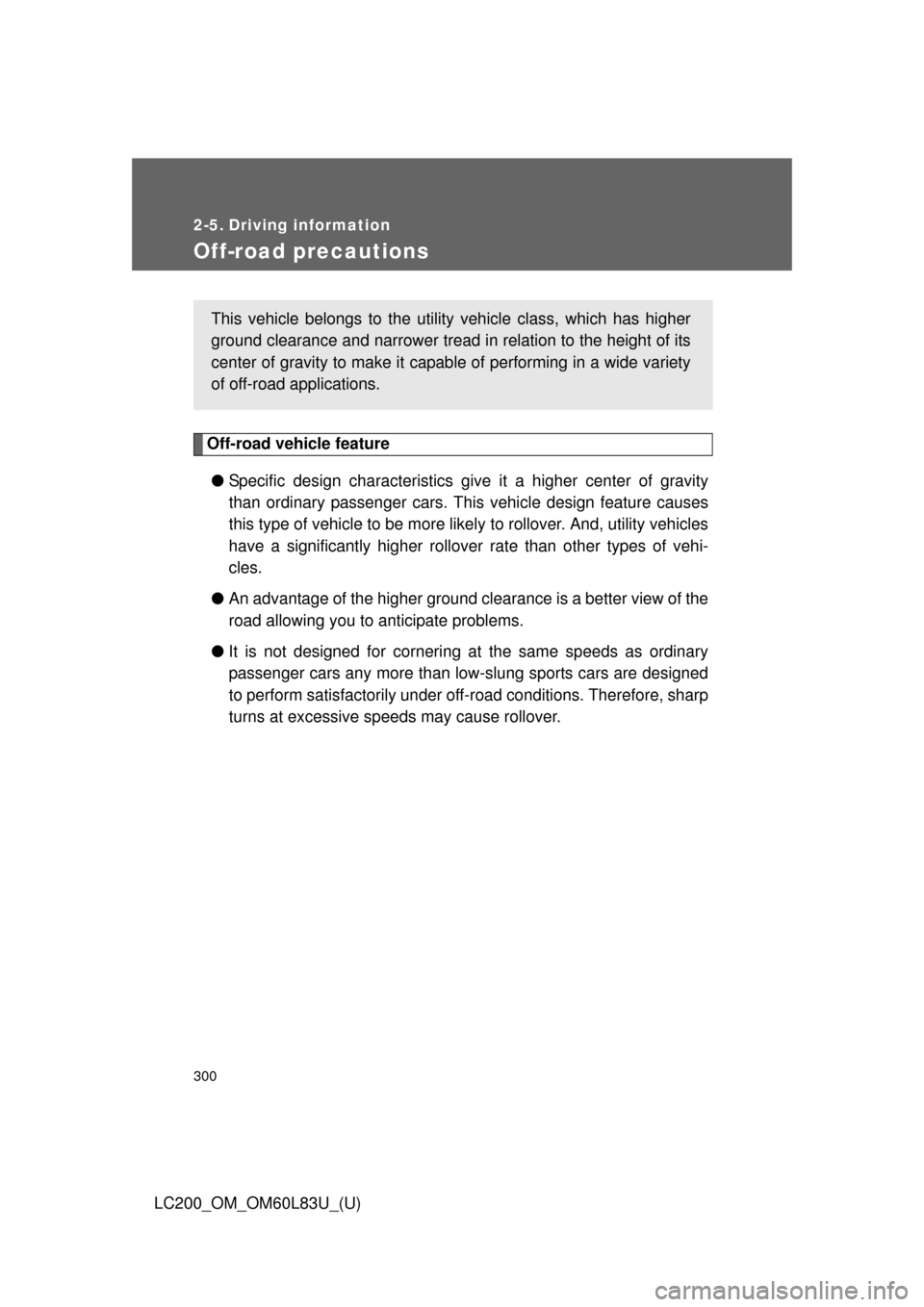
300
LC200_OM_OM60L83U_(U)
2-5. Driving information
Off-road precautions
Off-road vehicle feature● Specific design characteristics give it a higher center of gravity
than ordinary passenger cars. This vehicle design feature causes
this type of vehicle to be more likel y to rollover. And, utility vehicles
have a significantly higher rollover rate than other types of vehi-
cles.
● An advantage of the higher ground clearance is a better view of the
road allowing you to anticipate problems.
● It is not designed for cornering at the same speeds as ordinary
passenger cars any more than low-slung sports cars are designed
to perform satisfactorily under of f-road conditions. Therefore, sharp
turns at excessive speeds may cause rollover.
This vehicle belongs to the utility vehicle class, which has higher
ground clearance and narrower tread in relation to the height of its
center of gravity to make it capable of performing in a wide variety
of off-road applications.